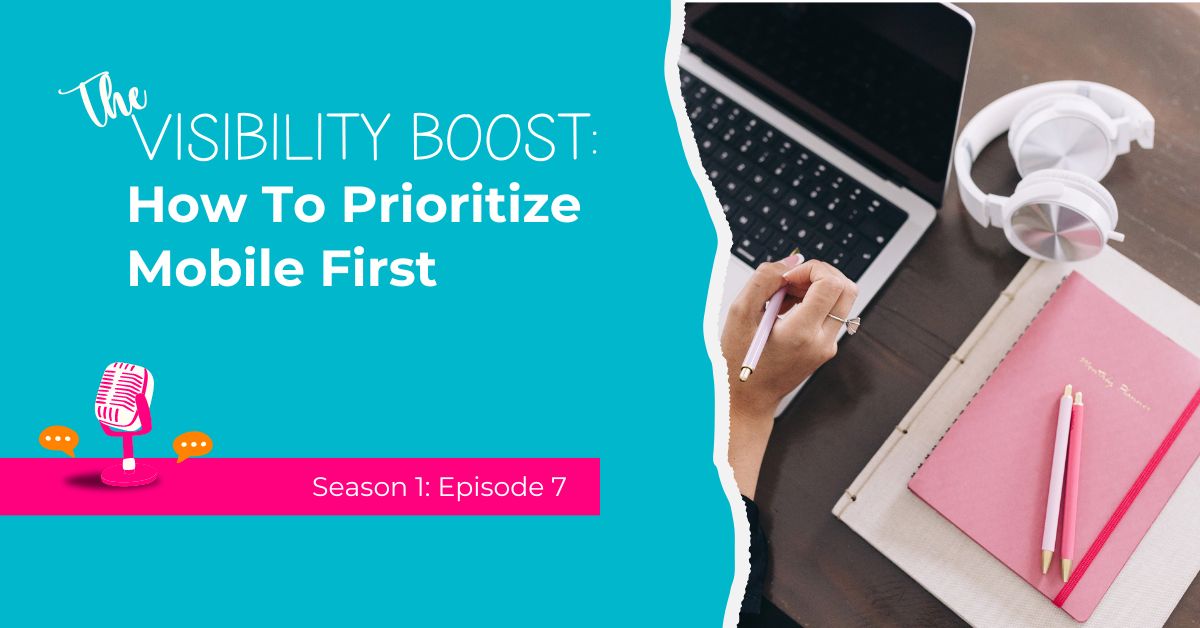Welcome to another episode of The Visibility Boost podcast! Today, we're delving into a critical aspect of online presence – Google's mobile-first approach to rankings. In this blog article, we'll explain what this means for business owners like you and explore practical steps to prioritize mobile first to ensure your website shines in the mobile landscape.

Google's shift towards prioritizing mobile-first rankings means your website must be mobile-friendly to stay ahead in the digital game. Let's explore the key steps you or your designer can take to prioritize mobile first.
The first and foremost step is to adopt a responsive design. Desktop and mobile screens differ significantly, and your website's design should adapt accordingly. If your developer isn't providing mock-ups for both desktop and mobile versions, it's time to raise questions.
Run your site through Google's Mobile-Friendly Test. This tool will assess whether your site is mobile-friendly and provide insights on necessary fixes if it falls short.
As discussed in a previous podcast, optimize your images. Large images can slow down your site, so be mindful of their size. Check out our earlier episode for in-depth tips on image optimization.
Incorporate an easy-to-use mobile navigation menu, commonly known as the “hamburger menu.” Align with user expectations for seamless navigation.
Given the small screens of mobile devices, ensure your font sizes are not only large enough but also dark enough for easy readability. Use online checkers to verify your font's readability against different background colors.
Buttons should be large enough for easy pressing, yet carefully spaced to avoid accidental taps. Strike a balance that ensures a user-friendly experience without frustrating users.
While desktops may load quickly, mobile performance can vary. Utilize Google's Page Speed Insights to assess and improve your mobile site speed.
Grab various devices and test your website's functionality. Can users easily navigate? Ensure your designer can hide non-essential elements on mobile screens for a streamlined experience.
For CMS users, especially on WordPress, opt for mobile-friendly plugins. These tools can enhance site speed without adding unnecessary weight to your website.
Regularly check your site's mobile usability using Google Search Console. Google offers free tools like Google Analytics, Search Console, and Page Speed Insights to empower you to optimize your website.
In a world where over 50% of users access websites through mobile devices, prioritizing mobile-friendly design is no longer an option but a necessity. As you embark on website redesigns or rebrands, ponder how mobile users will experience your site. Google equips us with invaluable tools – embrace them to ensure your website not only meets but exceeds the expectations of mobile and desktop users alike.
 Welcome! My name is Glenneth and I live in beautiful East Tennessee. I wear many hats: CEO of The Visibility Method, SEO & Google Ads Expert, content creator, and more. I love technology, social media, and weight lifting. My favorite place to hang out is the hammock in my backyard. My favorite colors are pink and orange. My favorite team is the Vols. And I LOVE to get email so please drop me a note and say hi!
Welcome! My name is Glenneth and I live in beautiful East Tennessee. I wear many hats: CEO of The Visibility Method, SEO & Google Ads Expert, content creator, and more. I love technology, social media, and weight lifting. My favorite place to hang out is the hammock in my backyard. My favorite colors are pink and orange. My favorite team is the Vols. And I LOVE to get email so please drop me a note and say hi!